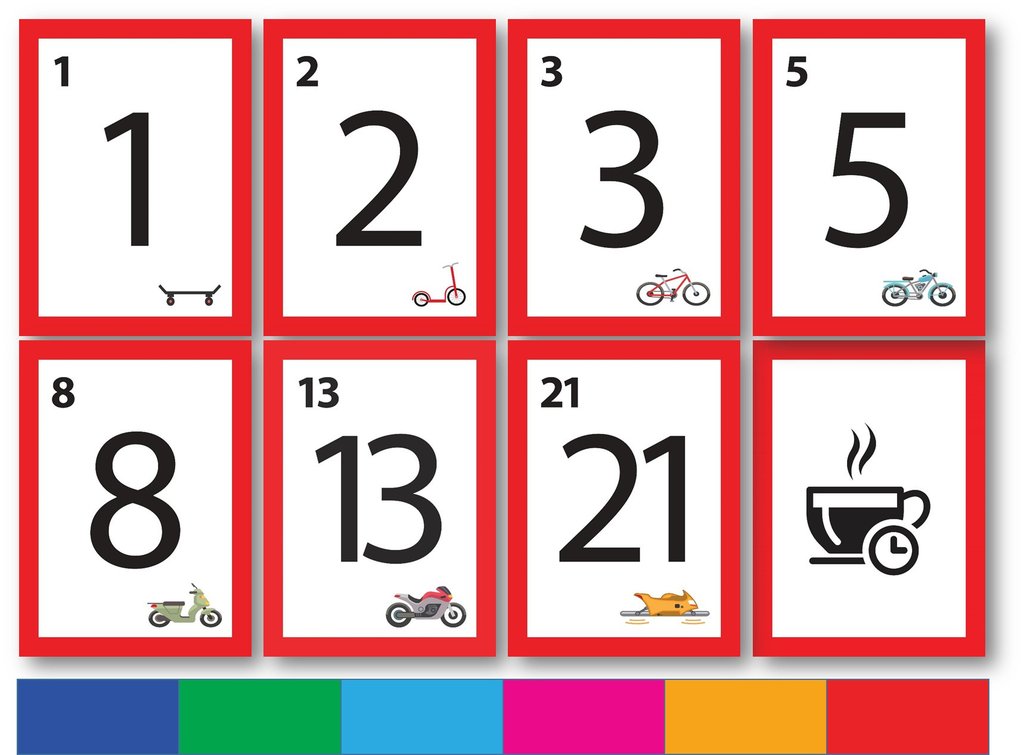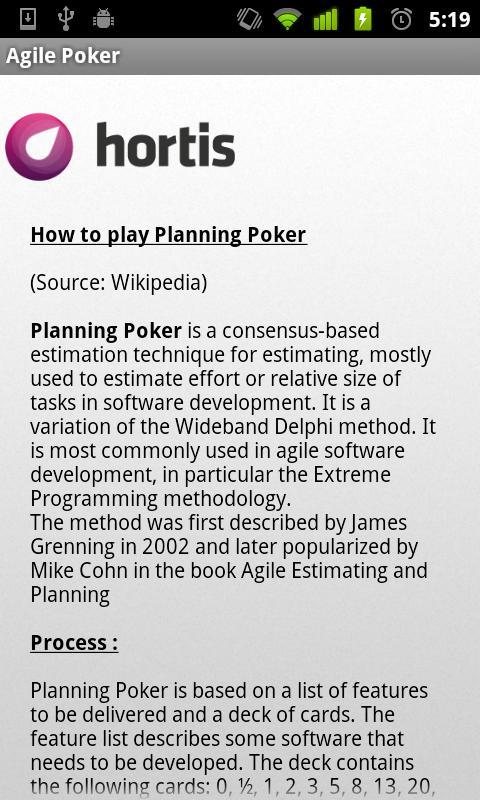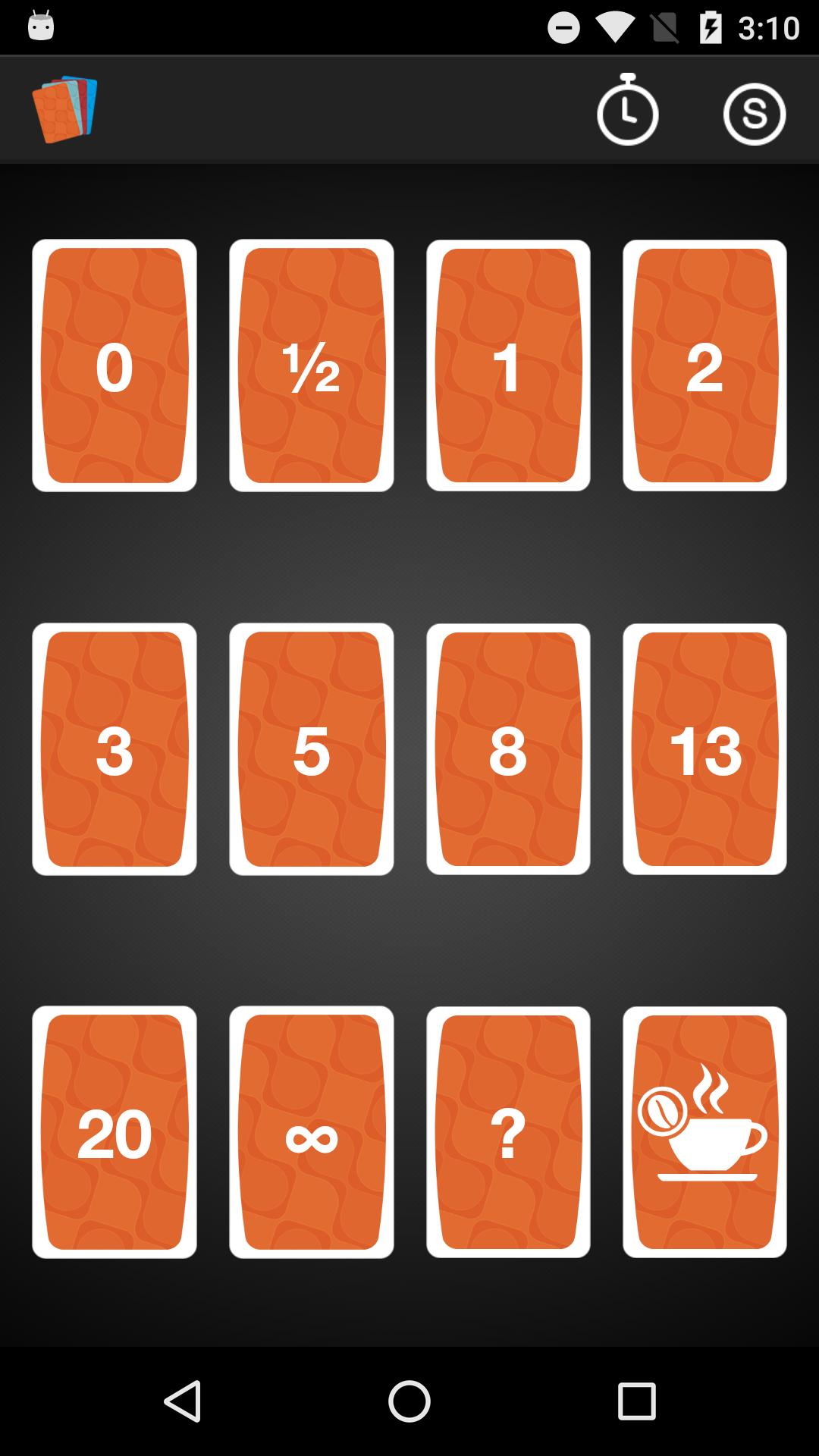Planning Poker Wikipedia
| WikiProject Computing | (Rated C-class, Mid-importance) | |||||||
|---|---|---|---|---|---|---|---|---|
| ||||||||
Why remove it?[edit]
it is an acurate description of an estimate method that works well.
- One pitfall of Planning Poker resides in making “convergence to consensus estimate” an obligation rather than a natural result of the conversation that follows a round of play. Doing so runs the risk of erasing useful information, i.e. The degree of uncertainty conveyed by a wide spread in the initial estimates.
- A handy deck of simple full-screen Planning Poker cards, with just enough configurability to let your Agile or Scrum team estimate tasks your way. No ads or other nonsense, just clean, crisp and easy to use.
- One of Wikipedia's core policies is WP:Verifiability. This article has no sources to allow other editors to verify the accuracy of the information. The WP:Notability guideline defines what topics are suitable for inclusion. If you can edit this article to conform to Wikipedia's guidelines and policies then it should remain. But if it does not conform then it should be removed. Sbowers3 (talk) 00:00, 23 January 2008 (UTC)
. an asterisk starts an unordered list. and this is another item in the list + or you can also use the + character - or the - character To start an ordered list, write this: 1. This starts a list.with. numbers + this will show as number '2'. this will show as number '3.' Wall Planning Poker is a variation of Planning Poker Card that is used to estimate more macro projects. Beyond of a hundred User Story, the use of Planning Poker Card is too long.
There are some references here: http://www.planningpoker.com/references.html. —Preceding unsigned comment added by 82.108.133.200 (talk) 13:43, 24 January 2008 (UTC)
- Saying so here (on the Talk page) doesn't help. What's needed is in the article page to add inline citations to reliable sources. Sbowers3 (talk) 15:13, 24 January 2008 (UTC)
The process includes the following step; Repeat the estimation process until a consensus is reached. The developer who was likely to own the deliverable has a large portion of the 'consensus vote', although the Moderator can negotiate the consensus.That is why the result reported in the Australian paper estimated by individual experts, achieved similar estimation accuracy as the planning poker tasks is no surprise. The outcome is readily predicable using statistical analysis. The link between 'planning poker' and Fibonacci numbers is not stated. In a nutshell, this article doesn't have value other than to propose a convoluted and time consuming method in lieu of estimates by individual experts.

The sentence about using Fib is very vague and provides little value. There is a good explanation why the math works here: http://www.yakyma.com/2012/05/why-progressive-estimation-scale-is-so.html— Preceding unsigned comment added by 105.27.198.70 (talk) 05:12, 6 July 2017 (UTC)
Contesting the proposed deletion[edit]
I'm going to have to disagree with the proposed deletion. As noted above, it is an accurate description of an estimating method that works well. The article does need to be cleaned up to point to proper references, and should also be re-written / re-organized to indicate that it's an estimation method, not just some obscure card game. Now, I guess I should probably do so... Shanemcd (talk) 21:16, 24 January 2008 (UTC)
Note from the original author[edit]
I could include citations and page references from Mike Cohn's book about ancoring and planning poker - is that ok?dave who walks (talk) 16;30, 1st February 2008 (GMT)
- It's probably okay in its current form. Thanks to other editors for providing references. I turned them into footnotes which all show up in the References section. It's always good to have more references but the ones there are good enough to show notability and verifiability. The IEEE reference is a very good indication of notability. Sbowers3 (talk) 02:44, 2 February 2008 (UTC)
In the interests of balance[edit]

A criticism section should be included. —Preceding unsigned comment added by 68.179.82.197 (talk) 12:29, 20 August 2009 (UTC)
- Why? Is there criticism about this estimation method? 200.114.149.47 (talk) 13:20, 6 October 2010 (UTC)
proposed merge[edit]
Planning poker is part of Scrum (software development), so I'm proposing a merge.
Also, since Planning poker seems part of Wideband delphi, Agile software development and Extreme programming, I'm not sure why it needs to exist as a separate article. EChastain (talk) 21:42, 2 February 2015 (UTC)
- It is also a method of its own right, which can be used in project management setups other than scrum. A lemma of its own is in order. --Mussklprozz (talk) 11:43, 20 February 2015 (UTC)
- Planning poker is a method on it's own for the estimation of tasks/workpackages. It is not only used in Scrum but can be used whereever it is necessary to leverage communication within a team and get estimates for planning. — Preceding unsigned comment added by Oemmler (talk • contribs) 11:48, 4 April 2017 (UTC)
The physical meaning[edit]
Why nothing about Enumerated type here?And also there is nothing about Punched cards (historical aspect). These cards remind me tickets for an exam at the universityUser:Bo85 (talk) 01:27, 20 November 2015 (UTC)
- What is there to say about them? --McGeddon (talk) 22:40, 19 November 2015 (UTC)
- I can say relating to web-development. List of discussed functions for development: for different functional there are different languages - high and low-level. The numerical value of the cards - the relative units of the complexity (story points) - different for different languages. Influence of participants depends on their knowledge of languages. The values on the cards for different people will mean a different time-slot/evaluation work from their perspective, depending on what level of the languages they work. For a different-level language-people assessment will vary depend on current story implementation language. But the standard of a particular language is the quality criterion (the direction of language development itself is also significant). Performance-critical/resource-constrained places ('keypoints' of the software) is written using low-level languages (C/C++/Asm? - backend-related). Development using a low-level languages can be even more long, but more cleverly relating to the amount of memory and program run time duration - taking and freeing the memory in C/C++ need to be manual for good program working in these critical places. It is a necessity. This code is written in man-hours more long time (card value has different meaning - more long time unit/period for development of the functional) on the one hand. On the other hand scripting languages (frontend-related) works with memory automatically, but consume resources more strongly. Need to do a lot of uniform work using these languages, but work is less valuable from this point of view. Also instead of coffee I think that rowan, hawthorn and rosehips tea from pharmacy - better. RippleSax (talk) 13:30, 28 November 2015 (UTC)
- Planning poker remind time sharing (investing) using protocol with marker. — Preceding unsigned comment added by RippleSax (talk • contribs) 14:58, 28 November 2015 (UTC)
- I can say relating to web-development. List of discussed functions for development: for different functional there are different languages - high and low-level. The numerical value of the cards - the relative units of the complexity (story points) - different for different languages. Influence of participants depends on their knowledge of languages. The values on the cards for different people will mean a different time-slot/evaluation work from their perspective, depending on what level of the languages they work. For a different-level language-people assessment will vary depend on current story implementation language. But the standard of a particular language is the quality criterion (the direction of language development itself is also significant). Performance-critical/resource-constrained places ('keypoints' of the software) is written using low-level languages (C/C++/Asm? - backend-related). Development using a low-level languages can be even more long, but more cleverly relating to the amount of memory and program run time duration - taking and freeing the memory in C/C++ need to be manual for good program working in these critical places. It is a necessity. This code is written in man-hours more long time (card value has different meaning - more long time unit/period for development of the functional) on the one hand. On the other hand scripting languages (frontend-related) works with memory automatically, but consume resources more strongly. Need to do a lot of uniform work using these languages, but work is less valuable from this point of view. Also instead of coffee I think that rowan, hawthorn and rosehips tea from pharmacy - better. RippleSax (talk) 13:30, 28 November 2015 (UTC)
Planning poker, also called Scrum poker, is a consensus-based, gamified technique for estimating, mostly used to estimate effort or relative size of development goals in software development. In planning poker, members of the group make estimates by playing numbered cards face-down to the table, instead of speaking them aloud. The cards are revealed, and the estimates are then discussed. By hiding the figures in this way, the group can avoid the cognitive bias of anchoring, where the first number spoken aloud sets a precedent for subsequent estimates.
Planning poker is a variation of the Wideband delphi method. It is most commonly used in agile software development, in particular in Scrum and Extreme Programming.
The method was first defined and named by James Grenning in 2002[1] and later popularized by Mike Cohn in the book Agile Estimating and Planning,[2] whose company trade marked the term [3] and a digital online tool.[4]
Process[edit]
Rationale[edit]
The reason to use planning poker is to avoid the influence of the other participants. If a number is spoken, it can sound like a suggestion and influence the other participants' sizing. Planning poker should force people to think independently and propose their numbers simultaneously. This is accomplished by requiring that all participants show their card at the same time.
Planning Poker Wikipedia
Equipment[edit]
Planning poker is based on a list of features to be delivered, several copies of a deck of cards and optionally, an egg timer that can be used to limit time spent in discussion of each item.
The feature list, often a list of user stories, describes some software that needs to be developed.
The cards in the deck have numbers on them. A typical deck has cards showing the Fibonacci sequence including a zero: 0, 1, 2, 3, 5, 8, 13, 21, 34, 55, 89; other decks use similar progressions with a fixed ratio between each value such as 1, 2, 4, 8, etc.
The reason for using the Fibonacci sequence instead of simply doubling each subsequent value is because estimating a task as exactly double the effort as another task is misleadingly precise. A task which is about twice as much effort as a 5, has to be evaluated as either a bit less than double (8) or a bit more than double (13).
Several commercially available decks use the sequence: 0, ½, 1, 2, 3, 5, 8, 13, 20, 40, 100, and optionally a ? (unsure), an infinity symbol (this task cannot be completed) and a coffee cup (I need a break, and I will make the rest of the team coffee). The reason for not exactly following the Fibonacci sequence after 13 is because someone once said to Mike Cohn 'You must be very certain to have estimated that task as 21 instead of 20.' Using numbers with only a single digit of precision (except for 13) indicates the uncertainty in the estimation. Some organizations[which?] use standard playing cards of Ace, 2, 3, 5, 8 and king. Where king means: 'this item is too big or too complicated to estimate'. 'Throwing a king' ends discussion of the item for the current sprint.
Smartphones allow developers to use mobile apps instead of physical card decks. When teams are not in the same geographical locations, collaborative software can be used as replacement for physical cards.
Planning Poker Scrum
Procedure[edit]
At the estimation meeting, each estimator is given one deck of the cards. All decks have identical sets of cards in them.
The meeting proceeds as follows:
- A Moderator, who will not play, chairs the meeting.
- The Product Owner provides a short overview of one user story to be estimated. The team is given an opportunity to ask questions and discuss to clarify assumptions and risks. A summary of the discussion is recorded, e.g. by the Moderator.
- Each individual lays a card face down representing their estimate for the story. Units used vary - they can be days duration, ideal days or story points. During discussion, numbers must not be mentioned at all in relation to feature size to avoid anchoring.
- Everyone calls their cards simultaneously by turning them over.
- People with high estimates and low estimates are given a soap box to offer their justification for their estimate and then discussion continues.
- Repeat the estimation process until a consensus is reached. The developer who was likely to own the deliverable has a large portion of the 'consensus vote', although the Moderator can negotiate the consensus.
- To ensure that discussion is structured; the Moderator or the Product Owner may at any point turn over the egg timer and when it runs out all discussion must cease and another round of poker is played. The structure in the conversation is re-introduced by the soap boxes.

The cards are numbered as they are to account for the fact that the longer an estimate is, the more uncertainty it contains. Thus, if a developer wants to play a 6 he is forced to reconsider and either work through that some of the perceived uncertainty does not exist and play a 5, or accept a conservative estimate accounting for the uncertainty and play an 8.

Benefits[edit]
A study by Moløkken-Østvold and Haugen[5] reported that planning poker provided accurate estimates of programming task completion time, although estimates by any individual developer who entered a task into the task tracker was just as accurate. Tasks discussed during planning poker rounds took longer to complete than those not discussed and included more code deletions, suggesting that planning poker caused more attention to code quality. Planning poker was considered by the study participants to be effective at facilitating team coordination and discussion of implementation strategies.
See also[edit]
- Comparison of Scrum software, which generally has support for planning poker, either included or as an optional add-on.
References[edit]
Planning Poker Wikipedia Free
- ^'Wingman Software Planning Poker - The Original Paper'. wingman-sw.com. Retrieved 5 July 2017.
- ^Mike Cohn (November 2005). 'Agile Estimating and Planning'. Mountain Goat Software. Retrieved 1 February 2008.
- ^'Planning poker - Trademark, Service Mark #3473287'. Trademark Status & Document Retrieval (TSDR). 15 January 2008. Retrieved 26 May 2014.
- ^Cohn, Mike. 'Planning Poker Cards: Effective Agile Planning and Estimation'. Mountain Goat Software. Mountain Goat Software. Retrieved 30 March 2016.
- ^K Moløkken-Østvold, NC Haugen (10–13 April 2007). 'Combining Estimates with Planning Poker—An Empirical Study'. 18th Australian Software Engineering Conference. IEEE: 349–58. doi:10.1109/ASWEC.2007.15. ISBN978-0-7695-2778-9.

Planning Poker Wikipedia Indonesia
- Mike Cohn (2005). Agile Estimating and Planning (1 ed.). Prentice Hall PTR. ISBN978-0-13-147941-8.